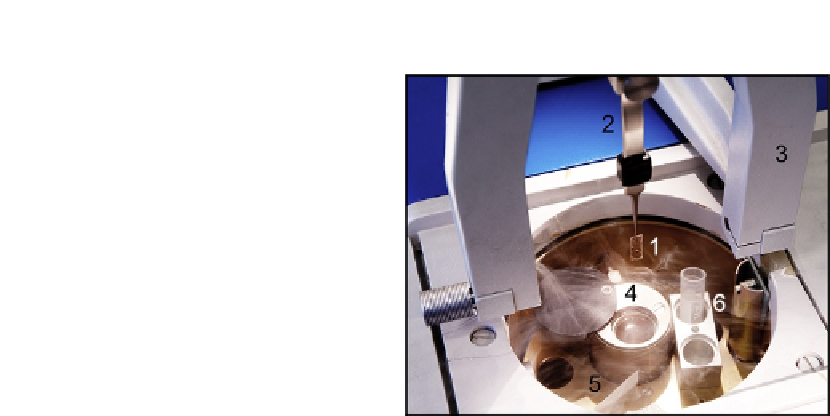Biology Reference
In-Depth Information
FIGURE 21.1
Freezing chamber of the KF-80 plunge-freezing unit. A mica sandwich (1) is held between
tweezers with a clamping ring (2) and is inserted into the forceps injector of the unit (only
the arc (3) of the injector is visible in the image). Upon shooting the sandwich in the
cryogen (4), it is freed of excess of cryogen by blotting it on a piece of filter paper (5) and
transferred to a perforated cryovial (6), using the tweezers (2) and taking care to
maintain the sandwich all the time below the rim of the freezing chamber.
21.3.1
Cell isolation, purification, and fixation
Single-cell suspensions are prepared in ice-cold PBS at a concentration of 10
10
6
cells/ml. For each individual sample, not taking into account experimental replicas
or the different antibodies to be used in the experiment, around 2
10
5
cells
are necessary. If the cells of interest need to be purified from a population via
antibody-dependent techniques (e.g., fluorescence-activated cell sorting or magnetic
bead-based separation), it is necessary to achieve this by depletion of the unwanted
cell population. In this way, the cells of interest will remain free of antibody at the
cell surface, permitting the use of colloidal gold-conjugated protein A as the second-
ary reagent for the immunogold labeling. Cells are fixed by addition of an equal
volume of ice-cold 4% PFA in PBS (2% final concentration) and kept on ice
for 30 min, followed by two washes with ice-cold PBS to remove free PFA. Resus-
pend the cells after the last wash in PBS
þ
0.1% BSA (w/v) at a concentration of
10
6
cells/ml and divide the cells in clean microcentrifuge tubes according to
the number of different antibody stains planned.
10
21.3.2
Immunogold labeling
Fixed cells are labeled on ice with saturating amounts of the primary antibody in
PBS
þ
0.1% BSA for 30 min. Spin the antibody solution for 1 min at full speed in
a benchtop centrifuge before adding to the cells. This removes antibody aggregates



